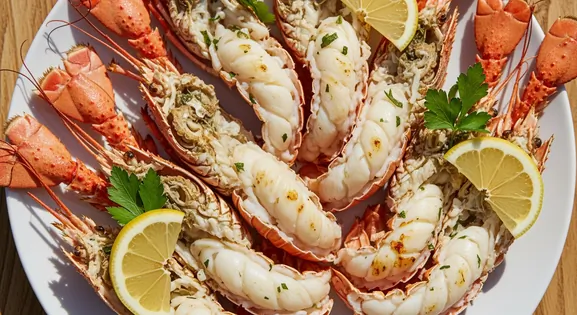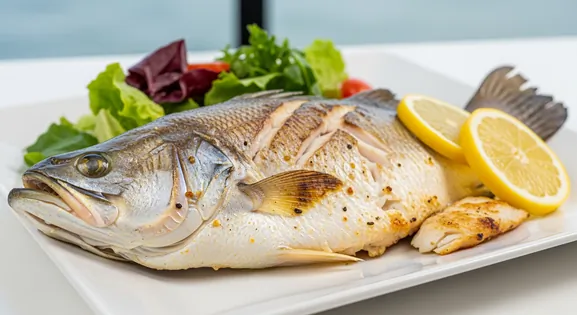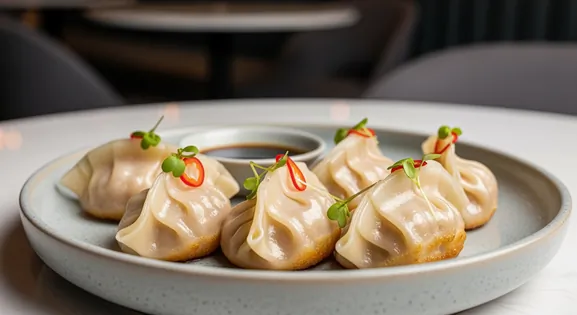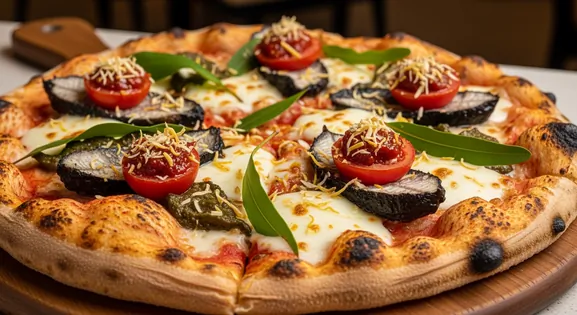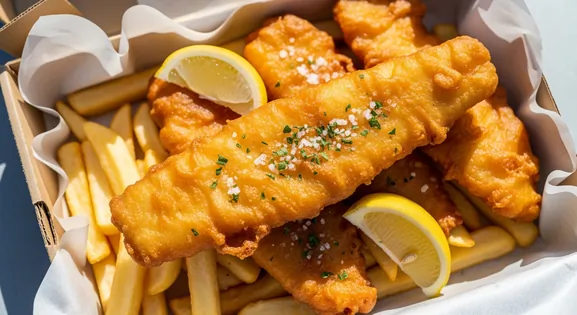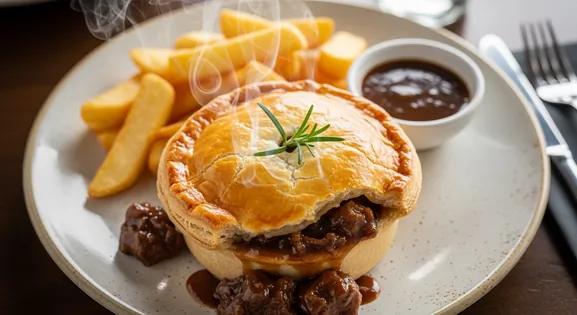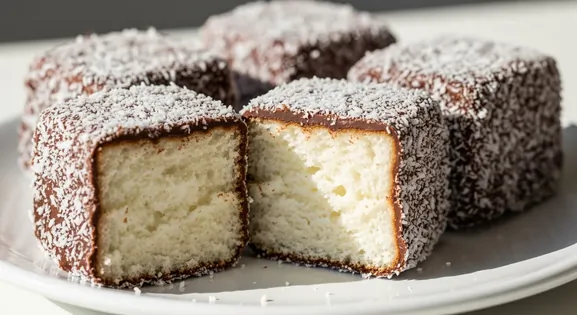Blue Swimmer Crab Linguine in Australia: A Complete Food Lover's Guide
Blue Swimmer Crab Linguine

Understanding This Dish: An Introduction
Blue Swimmer Crab Linguine is an elegant Australian-Italian fusion dish featuring sweet, delicate meat from the iconic blue swimmer crab (Portunus armatus), an Australian shellfish delicacy, combined with perfectly cooked al dente pasta. The dish typically showcases a light sauce of white wine, olive oil, garlic, and fresh herbs that complements rather than overwhelms the naturally sweet flavor of the crab. This sophisticated seafood pasta represents Australia's contemporary coastal cuisine, blending Mediterranean techniques with premium local seafood.
How It Is Traditionally Made
The dish begins with carefully extracting sweet meat from blue swimmer crabs, which are first cooked in salted water and then meticulously picked to remove all shell fragments. The pasta (typically linguine) is cooked to precise al dente texture. The sauce usually starts with sautéed garlic and sometimes shallots in olive oil, followed by a reduction of white wine. The crab meat is gently folded in rather than heavily cooked to preserve its delicate texture and flavor. Fresh herbs (commonly parsley) and a touch of chili are added at the end. Ensuring the crab is thoroughly cooked and handled with care throughout the process is crucial to maintaining its delicate flavor and quality.
Key Ingredients of Blue Swimmer Crab Linguine
Blue Swimmer Crab Meat
The star of the dish, this crab (Portunus armatus) is prized for its sweet, delicate, and flaky white meat. It's carefully picked from the shell to ensure no fragments remain.
Quality indicator: Look for bright white, moist, and tender flakes of crab meat with a naturally sweet, oceanic aroma.
Linguine Pasta
A long, flat, narrow pasta, linguine is ideal for coating with light sauces. It should be cooked al dente, meaning firm to the bite, providing a pleasant textural contrast to the soft crab.
Quality indicator: Quality linguine should be firm, not mushy or sticky, and maintain its shape without breaking easily.
Garlic and White Wine
These form the aromatic base of the sauce, providing a fragrant and slightly acidic counterpoint to the crab's sweetness. A dry white wine like Sauvignon Blanc or Pinot Grigio is typically used.
Quality indicator: The sauce should have a subtle, fresh garlic aroma and a balanced, bright acidity from the wine, not overpowering the crab.
What to Serve with This Dish
Crisp Australian Sauvignon Blanc
Wine
A dry, crisp Sauvignon Blanc from regions like Margaret River or Adelaide Hills offers bright acidity and citrus notes that cut through the richness of the pasta and complement the delicate sweetness of the crab.
Fresh Green Salad with Lemon Vinaigrette
Side Dish
A simple, lightly dressed green salad provides a refreshing contrast to the pasta, adding a crisp texture and a zesty, palate-cleansing element.
The Story Behind the Dish
This dish reflects Australia's evolving food culture and the significant Italian immigration influence on Australian cuisine. Blue swimmer crabs have been harvested in Australian waters for generations, but their incorporation into pasta dishes gained popularity during the 1980s and 1990s as Australia developed its own distinctive fusion cuisine. The strong Italian communities across Australia, with their culinary traditions, merged with access to superb local seafood to create dishes like this. Today, it represents high-end Australian seafood cuisine that honors both Mediterranean techniques and local ingredients.
Local Blue Swimmer Crab Linguine Variations in Australia
Chili Blue Swimmer Crab Linguine
A spicier version with a more generous amount of fresh or dried chili, sometimes incorporating nduja (spicy Italian pork paste) for additional heat and depth of flavor.
Creamy Blue Swimmer Crab Linguine
A richer variation that includes cream in the sauce, sometimes with a touch of tomato paste for color and flavor complexity. Often garnished with shaved parmesan cheese.
Blue Swimmer Crab and Prawn Linguine
Combines both crab meat and local prawns for a more varied seafood experience, typically in the same light garlic and white wine sauce base.
Cherry Tomato Blue Swimmer Crab Linguine
Incorporates burst cherry tomatoes for acidity and sweetness, often with added fresh basil rather than just parsley.
Blue Swimmer Crab with Fresh Pasta
A premium version using house-made fresh pasta instead of dried linguine, offering a more delicate texture that pairs wonderfully with the sweet crab meat.
A Traveler's Guide to Authenticity
What to Look For
-
Crab meat appears white and opaque
Properly cooked crab meat should be completely white or very slightly pinkish, never translucent or gray. Undercooked crab indicates poor quality and should be a red flag.
-
Pasta is served steaming hot
Seafood dishes should be served at proper temperatures to maintain quality. A steaming plate indicates the dish has been freshly prepared and held at optimal temperatures.
-
Clean, oceanic aroma without fishiness
Fresh crab has a sweet, oceanic smell. Any strong fishy or ammonia-like odors indicate the crab may not be fresh or has been improperly stored.
-
Visible chunks of crab meat throughout the dish
Quality versions of this dish showcase identifiable pieces of crab meat rather than tiny shreds or paste-like textures that might indicate lower quality or substitute products.
What to avoid
-
Strong fishy or ammonia smell
These odors indicate the crab is not fresh and could be a sign of spoilage. Fresh seafood should never smell strongly 'fishy' or like ammonia.
-
Gray or yellowish crab meat
Discolored crab meat may indicate spoilage or improper cooking. Properly cooked blue swimmer crab meat should be predominantly white.
-
Shell fragments mixed in with the pasta
Beyond being unpleasant to eat, shell fragments suggest hasty or careless preparation, which might indicate other corners being cut in the kitchen, including with food quality practices.
-
Pre-plated dishes sitting under heat lamps
Seafood pasta dishes should be made to order. Dishes kept warm for extended periods can develop quality issues and significantly diminish in flavor.
Explore Blue Swimmer Crab Linguine in Detail: City Guides
Discover where to find the best Blue Swimmer Crab Linguine and learn local tips in these cities:
Dietary Information
Dietary Information
Important Note for Travelers: Your safety is our priority. Below are the common allergens associated with the traditional preparation of this dish. However, recipes and ingredients can vary significantly between establishments. Always confirm all ingredients directly with the food vendor before ordering, especially if you have a severe allergy.
Potential Allergens
Dietary Suitability
How to Order Blue Swimmer Crab Linguine
Frequently Asked Questions about Blue Swimmer Crab Linguine
What is Blue Swimmer Crab Linguine?
This Australian-Italian fusion dish features al dente pasta tossed with sweet, delicate local blue swimmer crab meat (Portunus armatus). It's typically prepared with a light sauce of white wine, garlic, and olive oil, often with a touch of chili. It showcases Australia's excellent seafood in an elegant, Mediterranean-inspired preparation.
Is Blue Swimmer Crab a quality choice?
Blue Swimmer Crab is an excellent choice when properly cooked and sourced from clean waters. In Australia, these crabs are subject to strict fishing regulations and quality standards. The key quality factor is ensuring the crab is thoroughly cooked (the meat should be white and opaque, not translucent) and handled hygienically during preparation. Reputable restaurants typically source from suppliers who follow proper handling procedures.
How can I tell if Blue Swimmer Crab Linguine is fresh?
Fresh Blue Swimmer Crab Linguine should have a sweet, oceanic aroma, never fishy. The crab meat should be white, tender, and moist. Quality restaurants serve it immediately, with perfectly al dente pasta. The sauce should be light and glossy. Ask if the crab is fresh or frozen; fresh generally offers superior texture and sweetness.
What time of year is best for Blue Swimmer Crab in Australia?
Blue Swimmer Crabs are generally available year-round in Australia. However, the peak season in southern waters is typically during the warmer months from October through April, with the highest quality often found from November to March. During these months, crabs are more abundant, meatier, and at their sweetest.
Are there sustainable options for Blue Swimmer Crab?
Yes, Australian Blue Swimmer Crab fisheries are generally well-managed with quotas and size limits. Look for establishments mentioning sustainable sourcing or MSC certification. Some venues specify sourcing from regions known for sustainable practices, like South Australia's Spencer Gulf. Inquire about the crab's origin and sustainable harvesting practices.
Is Blue Swimmer Crab Linguine gluten-free?
Traditional Blue Swimmer Crab Linguine is not gluten-free due to wheat-based pasta. However, many establishments offer gluten-free pasta alternatives upon request. Always inform your server about dietary requirements and ask if sauce components are gluten-free. Also inquire about potential cross-contamination for severe sensitivities.
Expert How-To Guides about Blue Swimmer Crab Linguine
How to Identify Quality Blue Swimmer Crab Linguine
Look for these key indicators to ensure you're getting the best possible dish.
- Assess the aroma - it should smell fresh and oceanic with no fishy or ammonia notes.
- Examine the crab meat - it should be in visible chunks, not just tiny shreds, and have a clean white color with occasional blue or pink tinges.
- Check the pasta - it should be properly al dente (with slight resistance when bitten), not mushy or undercooked.
- Evaluate the sauce - it should lightly coat the pasta rather than drowning it, with a glossy appearance and subtle garlic and wine notes.
- Consider the temperature - the dish should arrive steaming hot, indicating it's freshly prepared.
- Look for fresh herbs (typically parsley) and perhaps a light touch of chili for authenticity.
How to Choose a Restaurant for Blue Swimmer Crab Linguine
Select an establishment most likely to serve high-quality, authentic crab pasta, ensuring a memorable culinary experience.
- Research restaurants that specifically mention sourcing local, sustainable seafood.
- Look for venues close to seafood markets or with direct relationships with fishers.
- Check if the restaurant mentions making pasta in-house or has an Italian influence in their cooking.
- Read reviews specifically mentioning their crab dishes or seafood pasta.
- Consider the price point - quality blue swimmer crab linguine typically commands a premium price reflective of the ingredient cost.
- Ask if they use fresh or frozen crab meat (fresh is generally superior for this particular dish).
- Inquire whether the dish is a regular menu item or seasonal special (seasonal often means fresher crab).
How to Eat Blue Swimmer Crab Linguine Like a Local
Enjoy this dish for the best experience, appreciating its delicate flavors and premium ingredients.
- Twirl the pasta using a fork, ensuring you get some crab meat in each bite.
- Don't be afraid to request extra bread for soaking up the flavorful sauce.
- Pair with a glass of Australian white wine, typically a Chardonnay or Pinot Grigio.
- Squeeze any provided lemon over the dish just before eating to brighten the flavors.
- Take your time - this is considered a premium dish meant to be savored slowly.
- It's perfectly acceptable to request a finger bowl if dealing with pieces of crab that still have shell.
Our Commitment to Quality
At Tasteplorers, our mission is to provide the most accurate and useful travel information in the world. To achieve this, all content on this site is created through our unique editorial framework. We utilize leading AI research tools, guided by our proprietary prompts, and a multi-stage validation process. This entire system is overseen by our editorial team to ensure everything we publish meets our high standards for accuracy, cultural nuance, and practical value for travelers.
Learn more about our Editorial Process and our Mission.
Explore regions
Europe
Discover Europe's diverse culinary landscape, from Mediterranean flavors to hearty Alpine fare. Learn to navigate markets, decode menus, and eat like a local.
Latin America & Caribbean
Discover the vibrant cuisines of Latin America & the Caribbean. Our expert guide covers everything from Mexican street food to Peruvian ceviche and market tips.
Oceania
Explore Oceania's diverse food scene. Learn about Polynesian earth ovens, Fijian feasts, and the vibrant café culture of Australia and New Zealand.
Southeast Asia
Explore Southeast Asia's diverse food cultures from Thailand to Vietnam. Get expert tips on navigating spice levels, choosing quality vendors, and understanding the rich traditions of the region.
